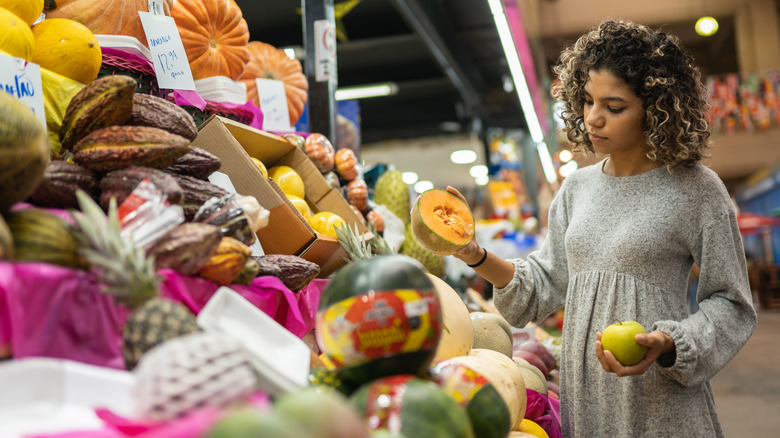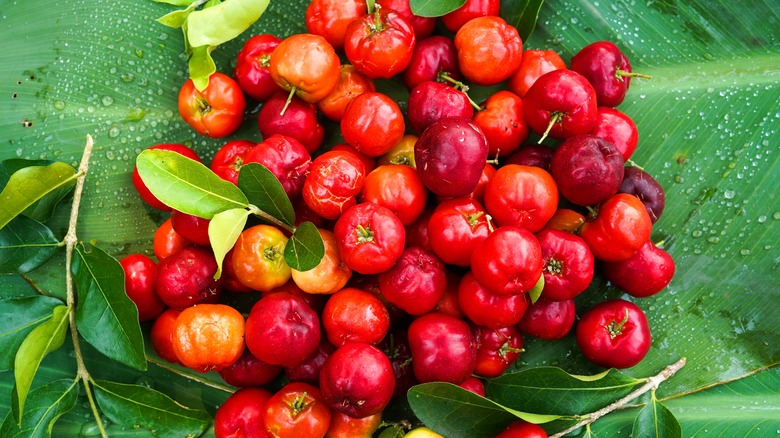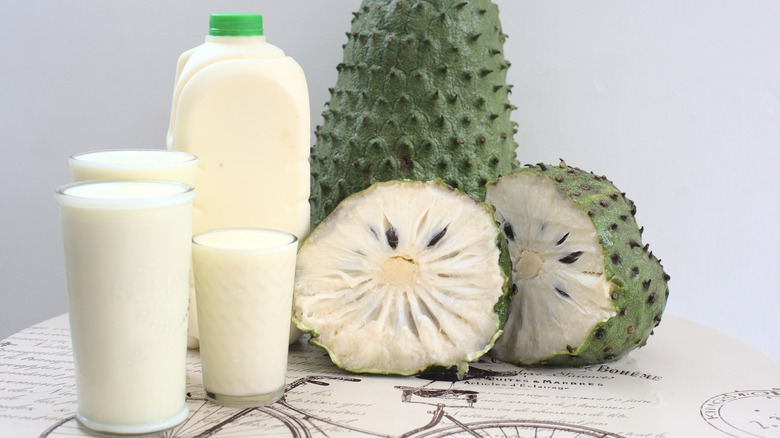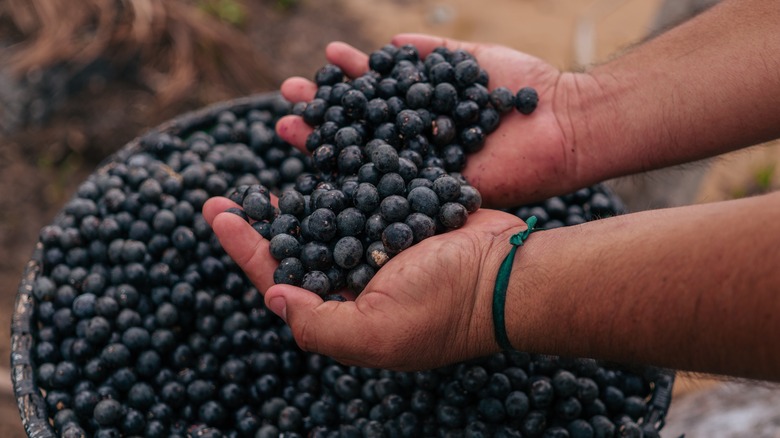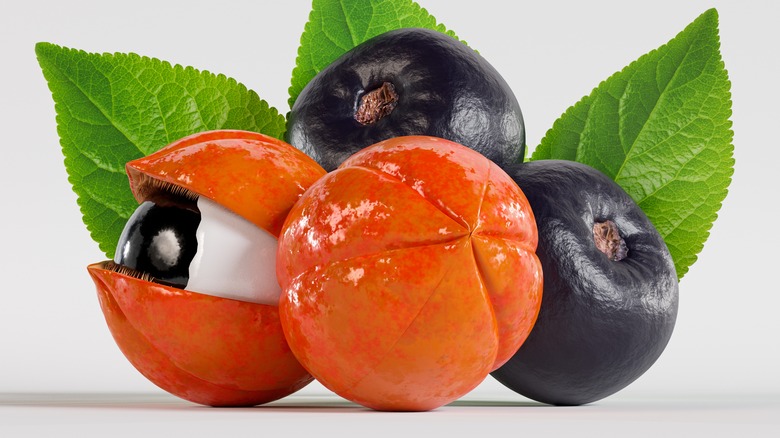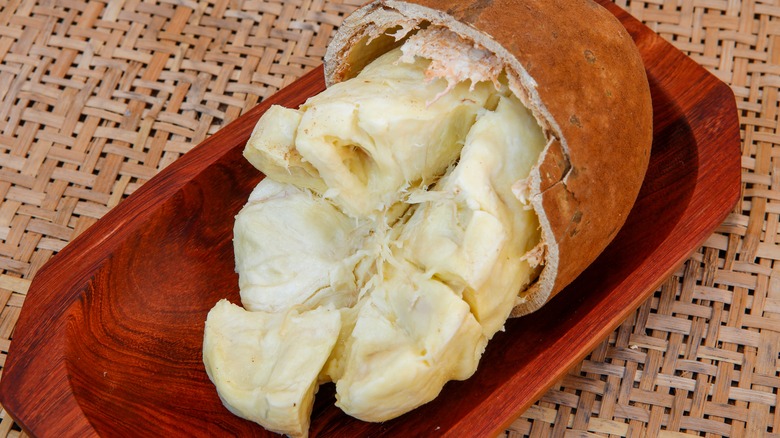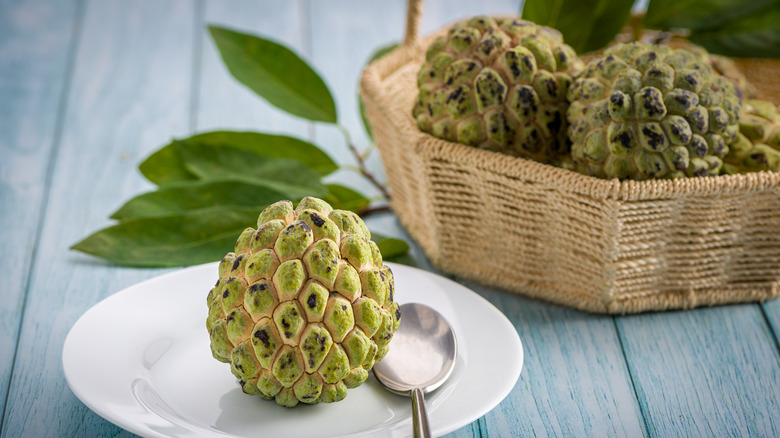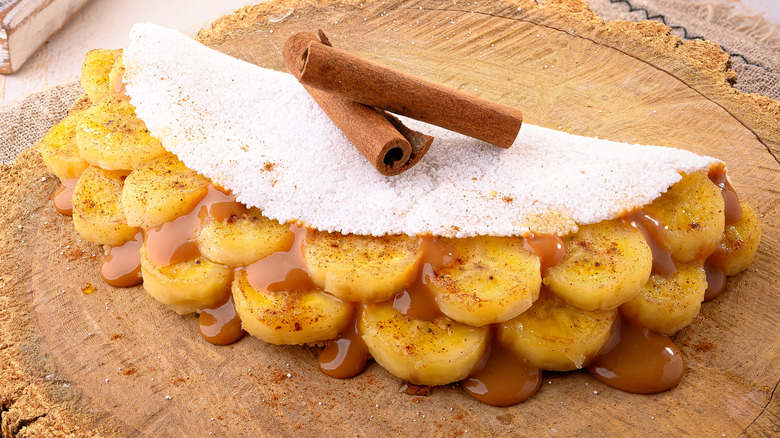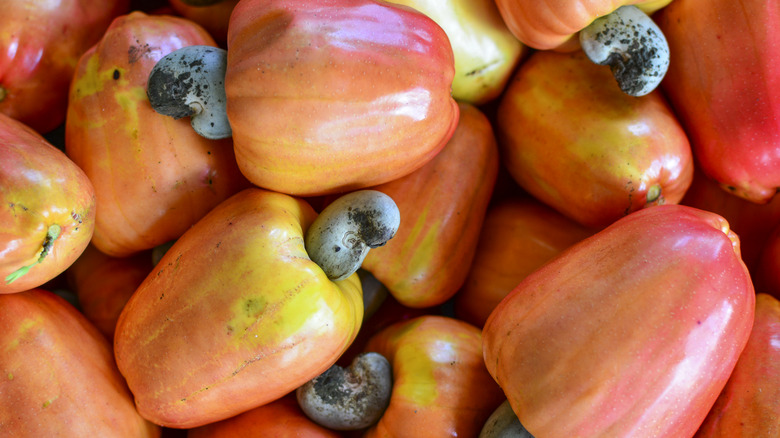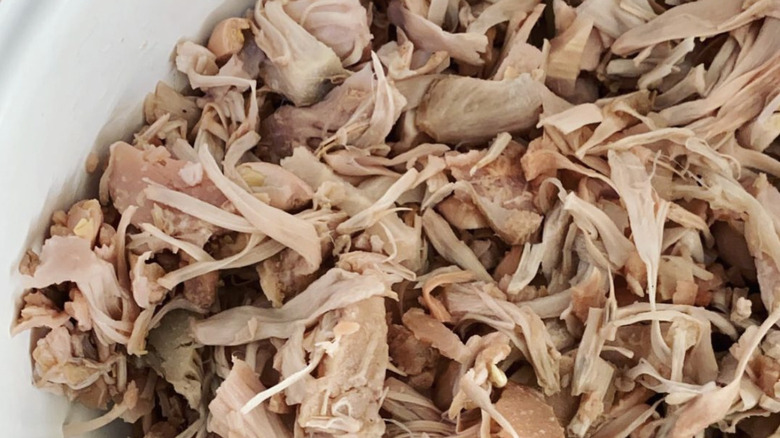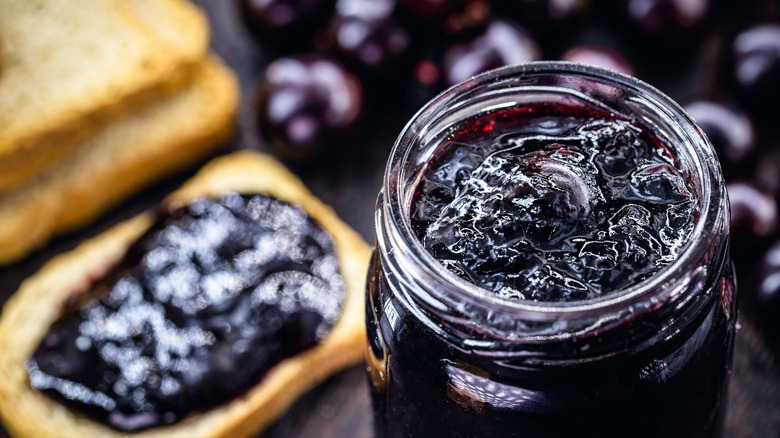10 Delicious Brazilian Fruits That Will Make You Want To Plan A Trip
When you imagine the fruits section of your local grocery store, what kind of produce do you picture? Maybe images of red delicious apples come to mind, or perhaps you envision honey dew melons, or even pears. However, chances are you don't think of graviola, guaraná, or cupuçú — three of the yummiest fruit options from Brazil.
Indeed, in the "Land of the Palms," as the Tupi people once called it, shoppers have access to many different kinds of fruit that aren't too common in the United States. This is because the South American country is home to dozens of unique fruits that range from tart to sugary in flavor.
Of course, many types of Brazilian produce — like pineapples or guavas — eventually make their way to the US. Considering that Brazil exports $1.2 billion worth of fruit per year, that only makes sense (via Ministério da Agricultura e Pecuária). That being said, there exist plenty of other Brazilian fruit varieties that remain relatively unknown to Americans. These are a few of our favorites.
1. Acerola fruits are small yet sour
At first glance, acerola fruits might look a little bit like cherries — and they taste like them too. This is because the acerola is distantly related to its delicious Eurasian counterpart. However, unlike cherries, which can often taste quite sweet, this Brazilian fruit is known for its notoriously tart flavor. In fact, some of them are so sour that they might bring a pucker to your lips!
Because of their super strong flavor, many Brazilians like to use acerola fruits in desserts. At the end of the day, they combine really well with sweeter ingredients. To try a bit of Brazilian-American fusion, cook the fruit down in sugar and then whip up a batch of classic cheesecake. If you drizzle your sweet acerola sauce on top, you will find that the tartness of the fruit provides the perfect balance to the richness of your dessert.
Another popular way to use this ingredient is in dipping sauces or even marinades for meat or fish. To achieve this, you can try throwing your acerola into the blender along with water, salt, cream, and a bit of sugar to even out the flavor. The result will be a natural sweet and sour sauce that is guaranteed to bring out the flavors of your favorite cut of steak.
2. Graviola fruit can add creaminess to your recipes
Whereas acerola fruits are sour, graviolas are sweet — not that you can tell by looking at them. You will probably notice that these delicoius Brazilian fruits are large and covered with spikes. In other words, they don't exactly scream "eat me!" That being said, once you taste graviola for the first time, you almost certainly won't regret it.
The flavor is creamy, sugary, and just a tad bit acidic. This makes graviola the ideal fruit to use in smoothies, milkshakes, or even ice cream. To prepare this fruit in one of the most traditional ways, throw it into the blender with some water and a few tablespoons of sweetened condensed milk. In this delightful smoothie, the natural cream tones of the fruit combine with the flavor of the condensed to create a drink that is absolutely decadent. Of course, the sugar element adds a sense of sweetness to the blend, giving you a think and luxurious taste.
Interestingly, some people in Brazil will take this traditional smoothie and turn it into a beachy cocktail. For the best results, just add a dollop of cachaça and a handful of ice to the mix, then sip it cold. The natural acidity of the fruit will accentuate the tangy flavor of the liquor, giving your drink a real punch.
3. Açaí is more than just a frozen treat
These days, açaí is famous in the United States as a so-called "superfood." And while this Brazilian fruit is often applauded for its nutritional content, it is almost never served in its freshest form. Instead, you can usually find it at a specialty store, frozen and blended into a thick paste that resembles ice cream. Oftentimes, it is served under a layer of toppings — like granola, nuts, and condensed milk — as if it was frozen yogurt.
Fascinatingly, there is a reason why we don't usually see fresh açaí in American grocery stores: The fruit spoils quickly. In fact, it is only good for about 48 hours after it has been harvested. Sometimes, the fruit can last for up to 72 hours after being picked; however, this is pushing the limits. As a result, most freshly picked açaí is rushed to processing centers, where it can be frozen and turned to sorbet as quickly as possible.
Because of this unique dynamic, you will have to head to Brazil to try fresh açaí — and not just any region will do. The northern state of Pará is perhaps the most famous for serving this delicacy, although you can also find it in most of the region surrounding the Amazon River. There, you can sink your teeth into this fruit, which tastes earthy like avocados.
4. Guaraná is the stuff of legends
No Brazilian fruit may be as mysterious as guaraná. This small fruit offers a tangy, acidic flavor and a whole lot of caffeine. In fact, as noted by Portal São Francisco, guaraná berries contain higher levels of the energizing substance than coffee beans. However, while you can enjoy this fruit in one of Brazil's popular "Guaraná" brand sodas or even a local energy drink, one of the best ways to experience it is through legend.
Indeed, guaraná's unique shape — which resembles a human eye — has long inspired Brazilian storytellers. The indigenous Tupi people who inhabited the region before the arrival of the Portuguese used to say that the fruit was the product of a terrible event.
According to legend, a young boy was bitten by a snake and died shortly after. Stricken with grief, the child's family asked Tupã, the god of thunder, to help them. The story goes that Tupã told the boy's parents to plant his eyes into the earth and wait for them to grow. Soon, the first guaraná plant appeared, allowing the child to always look out for his community. The fruit was said to give strength to people of all ages, helping them along with their survival.
5. Cupuaçu is sweet and sour
Cupuaçu is a delicious treat, but it can also be a handful — literally. This ovular Brazilian fruit tends to be quite large and can span up to around 10 inches in length. What's more, cupuaçu can weigh as much as 2.2 pounds, meaning that it is a great sharing fruit. It's also great for making juice. Just blend the fruit's soft interior with water and some sugar, then bask in the results.
In terms of flavor, cupuaçu is sweet and sour all at the same time. It is related to cacao, and has an intense taste similar to that of the more natural version of chocolate. As a result, the fruit can be used to make a chocolate alternative, called "cupulate." Or, it can be added to a number of other recipes — savory or otherwise.
However, if you want to enjoy chocolate and its cousin side-by-side, you can try cupuaçu mousse. In this delicious dessert, a sweetened and unprocessed version of the natural fruit is layered beneath a thick layer of chocolate mousse. Here, the acidity of the unprocessed fruit contrasts beautifully with the sweet chocolate layer, creating a dessert that is perfectly balanced. The best part is that the combination of the cupuaçu and cacao will give you a new perspective on chocolate as a whole.
6. Fruta-do-conde could change the way you look at pines
If you have ever seen a pine cone up close, chances are you didn't want to put it in your mouth. However, there is one type of Brazilian fruit that looks like a pine cone and tastes delicious. Fruta-do-conde is famous for its unique shape that many people call it "fruta-pinha," or "pine fruit" in Portuguese.
This delicious fruit tastes creamy and sweet. Like its much larger cousin, the graviola, the fruta-do-conde tastes fantastic in milkier recipes, like yogurts, puddings, and ice creams. However, unlike graviolas, frutas-do-conde aren't quite so acidic. This means that the so-called "pine fruit" doesn't generally pair as well with large quantities of sugar. It is also, perhaps, easier to consume this fruit in its natural form, as the meat itself is sugary enough to enjoy on its own.
Of course, it is important to recognize that, nicknames aside, frutas-do-conde do not grow on evergreen trees. In fact, they are actually harvested off of a tall leafy plant known in Latin as the Annona squamos. Because of this, these "pine fruits" do not actually have any relationship to pine cones, or pine trees, other than their unusual shape.
7. Banana prata makes a fantastic dessert ingredient
Bananas might not sound like a uniquely Brazilian fruit. After all, it is pretty easy to find them throughout the United States and Europe. That being said, Brazil has more banana varieties than you can typically find at a North American or European supermarket. Some of these include the "banana maçã," which is used to help an upset stomach, the "banana ouro," which is known for its high sugar content, and the "banana da terra," which is best consumed in savory recipes. However, one of our favorites is the "banana prata" — or "silver banana" — which seems to go perfectly in most desserts.
Indeed, the banana prata is not as sweet as the banana ouro, nor is it as earthy as the banana da terra. As a result, it adds a healthy portion of natural sugars to desserts ... without overpowering them. One of the best ways to prepare this ingredient is by cooking it down in a pan full of cinnamon and cloves.
In this marvelous combination, the banana will absorb some of the earthiness of the spices, giving it a balanced yet decadent flavor. If you are feeling decadent, you can serve this mixture in a tortilla made of tapioca flour. Douse the final result with dulce de leche for an additional burst of sweetness.
8. Cashew fruit might just surprise you
In the United States, it is pretty common to see people snacking on cashew nuts. However, the same cannot exactly be said about cashew fruits. These scrumptious bites actually grow on the same type of tree as the cashew nut. However, whereas the nut can be toasted and savored as a snack, the cashew fruit is best enjoyed fresh. After all, this delicious produce tastes earthy, sweet, and — yes — a little bit nutty all at the same time. And, these flavors are accentuated by the natural juiciness of the fruit.
To best enjoy the unique taste of the cashew fruit, try pressing it down into a nice cold cup of juice. Alternatively, you can try using it as a mixer for something stronger. In Brazil, many people crush the fruit and serve it with cachaça to make a cashew caipirinha. However, we also recommend trying it in this white sangria cocktail. Just substitute orange liqueur for cashew juice and enjoy! Do keep in mind, though, that the earthiness of the cashew fruit pairs best with dry white wines like a Riesling or a nice Sauvignon Blanc.
9. Jaca is the perfect vegan meat substitute
Whether you are on a vegan diet or are simply looking for a way to spruce up your Meatless Mondays, jaca fruit might be the way to go. This unique Brazilian fruit is large and meaty... and, when we say large, we mean large. Jaca fruits can weigh up to 110 pounds — meaning that their insides can contain a whole lot of flesh.
Interestingly, jaca fruits tend to have a similar consistency to slow-cooked meat. What's more, they are famous for having a more savory, if not salty, flavor. Because of this unique combination of characteristics, more and more Brazilian chefs are using jaca as a vegan meat substitute. These days, you can find jaca rolled into vegan meatballs, stuffed into sandwiches, or even stirred into stews. Some Brazilian pizza restaurants even offers vegan pizzas topped with imitation cheese and "shredded meat" made entirely out of jaca fruit.
The best part is that jaca is full of essential nutrients. The Brazilian outlet, Vitat, reports that the fruit contains plenty of minerals, like calcium, phosphorus, and magnesium. Additionally, jaca offers vitamins A, B-12, and C.
10. Jabuticaba could be the ingredient your jelly has been missing
If you are looking for a way to elevate your breakfast, try switching out your blueberry jam for jabuticaba preserves. Made with a dark purple Brazilian fruit, this delicacy looks like it could involve some combination of blueberries or blackberries. However, in terms of its flavor, jabuticaba will bring you to a whole new world.
Larger and, therefore, fleshier than blueberries, jabuticabas are known for their uniquely gooey interior. If you bite into a fresh one, you'll probably notice that it is mild, sweet, and yet very thick consistency-wise. Because of this, jabuticaba fruits are oftentimes used to make jams, jellies, or other canned preserves.
For a truly incredible experience, try spreading your jabuticaba preserves over some fresh cheese, preferably "queijo minas." Here, the sweet notes from the fruit will pair beautifully with the creaminess of the cheese, giving you something of a "cheesecake experience." Don't worry about adding these ingredients to crackers or even bread. If you eat this mixture plain, the flavors will speak for themselves.
